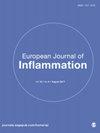Efficacy of thymosin-α-1 in patients with COVID-19: A systematic review and meta-analysis
IF 0.8
4区 医学
Q4 IMMUNOLOGY
引用次数: 0
Abstract
To identify whether thymosin-α-1 (Tα1) is effective in patients with Coronavirus disease 2019 (COVID-19) and to determine a suitable population for Tα1 treatment. We included studies with ≥10 cases and adults (aged ≥18 years) with laboratory-confirmed SARS-CoV-2 infection, data on mortality or length of hospitalization, disease severity, and study location, while excluded pregnant and breastfeeding women and minors. Publications were searched from November 1, 2019, to July 5, 2023, in six databases, including PubMed, Web of Science, Embase, Cochrane Library, China Knowledge Resource Integrated Database, and Wanfang Database. We separately utilized Newcastle-Ottawa Scale and Cochrane handbook methodology to evaluate risk of bias and used Review Manager (version 5.4, Cochrane Collaboration, Copenhagen, Denmark) to present and synthesize results. Relative risks (RR) and Standardized Mean Difference (SMD) with 95% confidence intervals (CI) were analyzed for dichotomous variables and continuous variables, respectively. Nine studies (participants = 5417) were included. No significant differences were found in mortality (nine studies; n = 5417; RR = 0.95; 95% CI: 0.56, −1.60; p = .84; I2 = 90%) or length of hospitalization (four studies; n = 3688; SMD = 0.16; 95% CI: −0.38, −0.69; p = .57; I2 = 96%) between patients with COVID-19 who did and did not receive Tα1. Participants were divided by the severity of the disease (serious and non-serious) and study location. Among the serious group, the incidence of death among patients who received Tα1 treatment was 0.67 times that of patients who did not receive Tα1 treatment (four studies; n = 1230; RR: 0.67; 95% CI: 0.58, −0.77; p < .00,001; I2 = 0%). There was no significant difference in length of hospitalization between the groups (two studies; n = 410; SMD = 0.66; 95% CI: −0.06, −1.38; p = .07; I2 = 87%). Among the non-serious group, compared to not having Tα1 treatment, receiving Tα1 treatment reduced hospitalization length (two studies; n = 3670; SMD = −0.28; 95% CI: −0.41, −0.14; p < .0001; I2 = 51%), while no significant difference in mortality (three studies; n = 3775; RR = 1.06; 95% CI: 0.22, −5.03; p = .94; I2 = 89%). Moreover, there was no significant difference between subgroups when divided by study locations (Studies within China: seven studies; n = 5263; RR = 1.14; 95% CI: 0.64, −2.04; p = .65; I2=92%; Studies outside of China: two studies; n = 154; RR = 0.41; 95% CI: 0.14, −1.24; p = .11; I2 = 51%). For patients with serious types of COVID-19, Tα1 significantly decreased mortality, which supports the utilization of Tα1 in patients with severe and critical types of COVID-19. Moreover, regarding hospitalization length, patients with non-serious COVID-19 who used Tα1 reduced their hospitalization length compared to those that did not use Tα1. However, these results have high heterogeneity and limited generalizability.胸腺肽-α-1对新冠肺炎患者的疗效:系统回顾和荟萃分析
确定胸腺肽-α-1(Tα1)对2019冠状病毒病(新冠肺炎)患者是否有效,并确定适合治疗Tα1的人群。我们纳入了对≥10例病例和实验室确诊感染严重急性呼吸系统综合征冠状病毒2型的成年人(年龄≥18岁)的研究,包括死亡率或住院时间、疾病严重程度和研究地点的数据,同时排除了孕妇、哺乳期妇女和未成年人。从2019年11月1日至2023年7月5日,在PubMed、Web of Science、Embase、Cochrane Library、中国知识资源综合数据库和万方数据库等六个数据库中检索出版物。我们分别使用Newcastle Ottawa量表和Cochrane手册方法来评估偏倚风险,并使用Review Manager(5.4版,Cochrane Collaboration,Copenhagen,Denmark)来呈现和综合结果。分别分析了二分变量和连续变量的相对风险(RR)和95%置信区间的标准化平均差(SMD)。包括9项研究(参与者=5417人)。在接受和未接受Tα1治疗的新冠肺炎患者的死亡率(9项研究;n=5417;RR=0.95;95%CI:0.56,−1.60;p=.84;I2=90%)或住院时间(4项研究;n=3688;SMD=0.16;95%CI:−0.38,−0.69;p=.57;I2=96%)方面未发现显著差异。参与者根据疾病的严重程度(严重和非严重)和研究地点进行划分。在严重组中,接受Tα1治疗的患者的死亡发生率是未接受Tα1治疗患者的0.67倍(四项研究;n=1230;RR:0.67;95%CI:0.58,-0.77;p<.00001;I2=0%)。两组之间的住院时间没有显著差异(两项研究;n=410;SMD=0.66;95%CI:−0.06,−1.38;p=.07;I2=87%)。在非严重组中,与未接受Tα1治疗相比,接受Tα-1治疗缩短了住院时间(两项研究;n=3670;SMD=−0.28;95%CI:−0.41,−0.14;p<.0001;I2=51%),而死亡率没有显著差异(三项研究;n=3775;RR=1.06;95%CI:0.22,−5.03;p=.94;I2=89%)。此外,按研究地点划分的亚组之间没有显著差异(中国境内研究:7项研究;n=5263;RR=1.14;95%CI:0.64,−2.04;p=.65;I2=92%;中国境外研究:2项研究;n=154;RR=0.41;95%CI:0.14,−1.24;p=.11;I2=51%)。对于严重型新冠肺炎患者,Tα1显著降低死亡率,这支持了Tα1在严重型和危重型新冠肺炎患者中的应用。此外,关于住院时间,使用Tα1的非严重新冠肺炎患者与未使用Tα2的患者相比,缩短了住院时间。然而,这些结果具有高度的异质性和有限的可推广性。
本文章由计算机程序翻译,如有差异,请以英文原文为准。
求助全文
约1分钟内获得全文
求助全文
来源期刊
CiteScore
0.90
自引率
0.00%
发文量
54
审稿时长
15 weeks
期刊介绍:
European Journal of Inflammation is a multidisciplinary, peer-reviewed, open access journal covering a wide range of topics in inflammation, including immunology, pathology, pharmacology and related general experimental and clinical research.

 求助内容:
求助内容: 应助结果提醒方式:
应助结果提醒方式:


